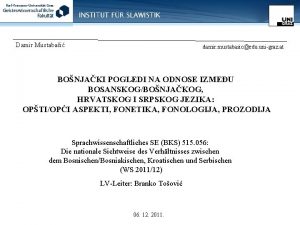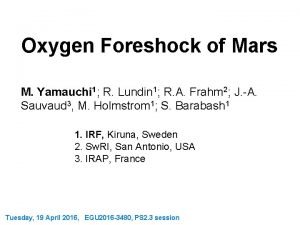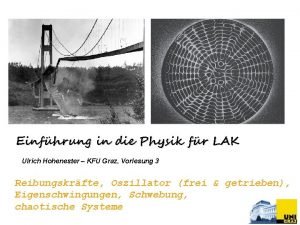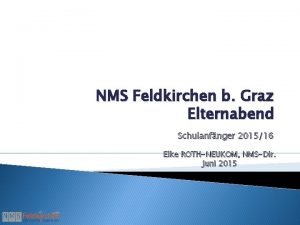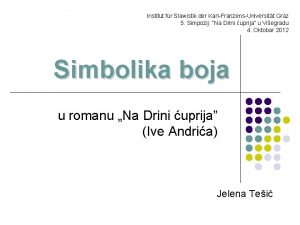KarlFranzensUniversitt Graz University of Graz Longterm trends of





























- Slides: 29

Karl-Franzens-Universität Graz University of Graz Long-term trends of magnetic bright points: The evolution of MBP size and modelling of the number of MBPs at disc centre D. Utz [1, 2, 3], T. Van Doorsselaere [3], E. Gagelmans [3], C. O´Rourke [3], A. Vuerinckx [3], R. Mueller [4], A. Veronig [1] IGAM/Institute of Physics, Karl-Franzens University Graz, Austria 1 Instituto de Astrofísica de Andalucía, CSIC, Granada, Spain 2 Centre for mathematical Plasma Astrophysics - KU Leuven, Belgium 3 Observatoire Pic du Midi – University of Toulouse, France 4 In the frame of FWF Project: P 27800: The interaction of the solar granulation with small-scale magnetic fields 6/7/2021 Dominik Utz Hinode-12: The many Suns 1

Karl-Franzens-Universität Graz University of Graz • Contents of the Talk Part I: Motivation and Introduction – – – • Part II: Longtime Activity of MBPs – – – • Solar Magnetic Fields and the solar cycle Appearance of MBPs Basic Properties of MBPs Size of MBPs at disc centre Number of MBPs at disc centre Correlation analysis Part III: Modelling and Conclusions – 6/7/2021 Modelling the change of MBPs as a function depending on the sunspot number Dominik Utz Hinode-12: The many Suns 2

Karl-Franzens-Universität Graz University of Graz Part I: Basics about MBPs 6/7/2021 Dominik Utz Hinode-12: The many Suns 3

Karl-Franzens-Universität Graz University of Graz Top right: Sunspot with spectrograph slit and the seen line splitting within the sunspot; right: Sunspot Butterfly diagram; top: The X-ray variable solar corona as seen by Japanese Yokoho mission; 6/7/2021 Dominik Utz Hinode-12: The many Suns 4

Karl-Franzens-Universität Graz University of Graz A whole hierachy of magnetic fields exists: Taken from: Zwaan 1987: Elements and patterns in the solar magnetic field 6/7/2021 Dominik Utz Hinode-12: The many Suns 5

Karl-Franzens-Universität Graz University of Graz Small-Scale Fields? Right: Jin et al. 2011 in The Sun´s small-scale magnetic elements in Solar Cycle 23; Obviously there is a huge controversial debate going on! 6/7/2021 Dominik Utz Hinode-12: The many Suns 6

Karl-Franzens-Universität Graz University of Graz Observational characteristics right top: Among the first ro report about “solar filigree” -> Dunn & Zirker 1973 left top: probably the first time that the G-band gets used -> Muller & Roudier 1984 right: “modern” high resolution observations -> Berger et al. 2004 6/7/2021 Dominik Utz Hinode-12: The many Suns 7

Karl-Franzens-Universität Graz University of Graz Magnetic Bright Points • Small scale magnetic flux concentrations – – – k. G fields ~ 200 km diameters Bright (especially in the G-band) Found in intergranular regions Lifetimes in min. range • Theoretical Models – Single isolated flux tubes • In the higher atmosphere canopy structue – Created by convective collapse process 6/7/2021 Dominik Utz Hinode-12: The many Suns 8

Karl-Franzens-Universität Graz University of Graz Atmospheric coupling: 6/7/2021 Dominik Utz Hinode-12: The many Suns 9

Karl-Franzens-Universität Graz University of Graz Part II: Long-time variations of MBPs 6/7/2021 Dominik Utz Hinode-12: The many Suns 10

Karl-Franzens-Universität Graz University of Graz 6/7/2021 Dominik Utz Hinode-12: The many Suns 11

Karl-Franzens-Universität Graz University of Graz • MBP size distributions: e. g. Abramenko et al. 2010 6/7/2021 Dominik Utz Hinode-12: The many Suns 12

Karl-Franzens-Universität Graz University of Graz 6/7/2021 Dominik Utz Hinode-12: The many Suns 13

Karl-Franzens-Universität Graz University of Graz 6/7/2021 Dominik Utz Hinode-12: The many Suns 14

Karl-Franzens-Universität Graz University of Graz 6/7/2021 Dominik Utz Hinode-12: The many Suns 15

Karl-Franzens-Universität Graz University of Graz Possible Interpretation: The MBP size is really distributed according to an exponential function but truncated to the smaller sizes by the telescope resolution (diffraction limit). Thus the scale parameter tells us about the physics and the shape parameter about the telescope and the quality of observations. 6/7/2021 Dominik Utz Hinode-12: The many Suns 16

Karl-Franzens-Universität Graz University of Graz 6/7/2021 Dominik Utz Hinode-12: The many Suns 17

Karl-Franzens-Universität Graz University of Graz 6/7/2021 Dominik Utz Hinode-12: The many Suns 18

Karl-Franzens-Universität Graz University of Graz • The main observational findings for the size distribution: – The size distribution of MBPs follows a Gamma distribution – The size of MBPs is variable with the solar cycle showing larger scale paramters during more active times and lower scale parameters, i. e. smaller sizes and steeper distributions during less active Sun – Moreover the shape parameter is variable indicating a changing telescope quality • Interpretation: • The 2 paramters of the Gamma distribution can be interpreted as – Scale parameter true physica size dependence follows an exponential function and is variable with the solar cycle – Shape parameter can be interpreted as diffraction limit cut off and thus models the telescope quality and principle resolution limit • For more details see: Utz D. , et al. 2018, A&A, under preparation: Long-term trends of magnetic bright points. II. Number of magnetic bright points at disc centre and Utz D. , et al. 2018 6/7/2021 Dominik Utz Hinode-12: The many Suns 19

Karl-Franzens-Universität Graz University of Graz 6/7/2021 Dominik Utz Hinode-12: The many Suns 20

Karl-Franzens-Universität Graz University of Graz Monthly median MBP number at disc centre 6/7/2021 Dominik Utz Hinode-12: The many Suns 21

Karl-Franzens-Universität Graz University of Graz 6/7/2021 Dominik Utz Hinode-12: The many Suns 22

Karl-Franzens-Universität Graz University of Graz Part III: Modelling and Conclusions 6/7/2021 Dominik Utz Hinode-12: The many Suns 23

Karl-Franzens-Universität Graz University of Graz 6/7/2021 Dominik Utz Hinode-12: The many Suns 24

Karl-Franzens-Universität Graz University of Graz 6/7/2021 Dominik Utz Hinode-12: The many Suns 25

Karl-Franzens-Universität Graz University of Graz 6/7/2021 Dominik Utz Hinode-12: The many Suns 26

Karl-Franzens-Universität Graz University of Graz 6/7/2021 Dominik Utz Hinode-12: The many Suns 27

Karl-Franzens-Universität Graz University of Graz • The main observational findings: – The small-scale magnetic field activity (see by MBPs) is related to the solar cycle – But there are different time lags for the descending and ascending phase of cycle 23/24 • Modelling: – The sunspots should be responsible for the magnetic field activity in the network – Leading to a model with 4 major input paramters • Interpretation: – With caution due to the many fitting parameters and low certainty (a multitude of possible solutions exist)! – While the number of MBPs seems to be dominated by the old sunspot flux in the decreasing phase (large „a“ coefficient and high time lag), the number of MBPs is driven more directly during the rising phase (lower „a“ number with nearly no temporal shift). – During the rising phase the MBP decay parameter „c“ is increased as well as the number of background MBPs (factor ~ 2. 5) indicating that the plasma dynamics is much higher during the rising phse leading to a faster transport of flux out of the center of the Sun (increased decay parameter) as well as to a larger background activity (increased small-scale dynamo). • For more details see: Utz D. , et al. 2016, A&A, 585, 39: Long-term trends of magnetic bright points. I. Number of magnetic bright points at disc centre and Utz D. , Muller R. , Van Doorsselaere T. , 2017, PASJ: Temporal relations between magnetic bright points and the solar sunspot cycle under review 6/7/2021 Dominik Utz Hinode-12: The many Suns 28

Karl-Franzens-Universität Graz University of Graz Thank you for your attention and the whole Hinode team for the great data and work done over all the years! Cartoons taken from the internet (all rights reserved by the respective authors) 6/7/2021 Dominik Utz Hinode-12: The many Suns 29
 Thomas silverstein
Thomas silverstein Lts kernel
Lts kernel Https //checkin.tugraz.at
Https //checkin.tugraz.at Graz austria map
Graz austria map Dreihackengasse 11
Dreihackengasse 11 Itat graz
Itat graz Hodza u graz muhamed
Hodza u graz muhamed Razgovorni stil primjer
Razgovorni stil primjer Ernst fuchs kirche
Ernst fuchs kirche Efkon graz
Efkon graz Websokrates bs tirol
Websokrates bs tirol Nada therapie
Nada therapie Yamauchi graz
Yamauchi graz Sz bauwerksabdichtung graz
Sz bauwerksabdichtung graz Kinderschutzzentrum graz
Kinderschutzzentrum graz Normalkraft
Normalkraft Cw schule graz
Cw schule graz Biobank graz
Biobank graz Fahrzeugbeschriftung graz-umgebung
Fahrzeugbeschriftung graz-umgebung Arbeitsmedizinische untersuchung fit2work
Arbeitsmedizinische untersuchung fit2work Sokrates web graz
Sokrates web graz Slawistik graz
Slawistik graz Institut für slawistik graz
Institut für slawistik graz Sandra hummel uni graz
Sandra hummel uni graz Nms feldkirchen klassen
Nms feldkirchen klassen 沈榮麟
沈榮麟 Trends and issues in nursing
Trends and issues in nursing Trends of 1950s
Trends of 1950s Modern trends in criminology
Modern trends in criminology New trends in pediatric nursing
New trends in pediatric nursing






